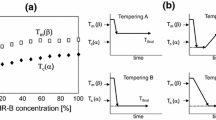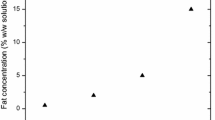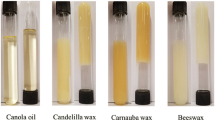Abstract
Uniform suspension of particulates (salt or spices) in oil-based marinades requires a gel behavior of the matrix. This can be achieved by adding a solid fat to the liquid oil. Besides rheology, appearance and thermal stability are important for the utilization as marinades. The influence of solid fat concentration (c fat = 2.5–5.5 wt%) and average cooling speed (1.4, 2.6, and 4.7 °C/min) on the functional properties of oil-fat gels from palm fat and canola oil was investigated. Oil-fat mixtures showed complex physiochemical behavior depending on the solid fat concentration and cooling rate. All samples had a shear-thinning behavior. Yield stresses and apparent viscosities increased at a constant cooling rate with increasing solid fat concentration. Frequency dependence of storage and loss modulus showed a transition from a viscous solution to a weak gel at c fat > 3.5 wt%. Samples at increasing cooling rates transitioned to weak gels at lower fat concentration (2.5 wt%). Mixtures became turbid and increasingly whiter as both solid fat concentration and cooling rates increased, which was explained by increased light-scattering by fat crystal aggregates. Results show the critical importance of proper formulation and preparation conditions on the functionality of oil-based marinades.









Similar content being viewed by others
References
Yusop SM, O’Sullivan MG, Kerry JP (2011) Marinating and Enhancement of the Nutritional Content of Processed Meat Products. In: Kerry JP, Kerry JF (eds) Processed Meats: Improving Safety, Nutrition and Quality. Woodhead Publishing, Cambridge, pp 421–449
Feiner G (2006) Meat Products Handbook: Practical Science and Technology. Woodhead Publishing, Cambridge
McEvoy JH (2003) The Might of Marinades. Prepared Foods 172:49–58
Xiong YL, Mikel WB (2001) Meat and Meat Products. In: Hui YH, Nip W-K, Rogers RW, Young OA (eds) Meat Science and Applications. Marcel Dekker, New York, pp 351–370
Pernetti M, van Malssen KF, Flöter E, Bot A (2007) Structuring of Edible Oils by Alternatives to Crystalline Fat. Curr Opin Colloid Interface Sci 12:221–231
Vintiloiu A, Leroux J-C (2008) Organogels and Their Use in Drug Delivery—a Review. J Controlled Release 125:179–192
Bot A, Veldhuizen YSJ, den Adel R, Roijers EC (2009) Non-Tag Structuring of Edible Oils and Emulsions. Food Hydrocolloids 23:1184–1189
Rogers MA (2009) Novel Structuring Strategies for Unsaturated Fats—Meeting the Zero-Trans, Zero-Saturated Fat Challenge: A Review. Food Res Int 42:747–753
Co ED, Marangoni AG (2012) Organogels: An Alternative Edible Oil-Structuring Method. J Am Oil Chem Soc 89:749–780
Narine SS, Marangoni AG (1999) Relating Structure of Fat Crystal Networks to Mechanical Properties: A Review. Food Res Int 32:227–248
Kloek W, Walstra P, Vliet T (2000) Nucleation Kinetics of Emulsified Triglyceride Mixtures. J Am Oil Chem Soc 77:643–652
Kloek W, van Vliet T, Walstra P (2005) Mechanical Properties of Fat Dispersions Prepared in a Mechanical Crystallizer. J Texture Stud 36:544–568
Walstra P (2003) Physical Chemistry of Foods. Marcel Dekker, New York
Vreeker R, Hoekstra LL, den Boer DC, Agterof WGM (1992) The Fractal Nature of Fat Crystal Networks. Colloids and Surf 65:185–189
Van den Tempel M (1961) Mechanical Properties of Plastic-Disperse Systems at Very Small Deformations. J Colloid Sci 16:284–296
Tang D, Marangoni AG (2006) Quantitative Study on the Microstructure of Colloidal Fat Crystal Networks and Fractal Dimensions. Adv Colloid Interface Sci 128–130:257–265
Marangoni AG, Tang D (2008) Modeling the Rheological Properties of Fats: A Perspective and Recent Advances. Food Biophys 3:113–119
Kloek W, van Vliet T, Walstra P (2005) Large Deformation Behavior of Fat Crystal Networks. J Texture Stud 36:516–543
Acevedo NC, Marangoni AG (2010) Characterization of the Nanoscale in Triacylglycerol Crystal Networks. Cryst Growth Des 10:3327–3333
Acevedo NC, Marangoni AG (2010) Toward Nanoscale Engineering of Triacylglycerol Crystal Networks. Cryst Growth Des 10:3334–3339
Acevedo NC, Peyronel F, Marangoni AG (2011) Nanoscale Structure Intercrystalline Interactions in Fat Crystal Networks. Curr Opin Colloid Interface Sci 16:374–383
Kamphuis H, Jongschaap RJJ (1985) The Rheological Behaviour of Suspensions of Fat Particles in Oil Interpreted in Terms of a Transient-Network Model. Colloid Polym Sci 263:1008–1024
Papenhuijzen JMP (1972) The Role of Particle Interactions in the Rheology of Dispersed Systems. Rheol Acta 11:73–88
Sherman P (1968) The influence of particle size on the viscoelastic properties of flocculated emulsions. 5th International Conference on Rheology, Kyoto, Japan, pp. 327–338
Marangoni AG, Rousseau D (1996) Is Plastic Fat Rheology Governed by the Fractal Nature of the Fat Crystal Network? J Am Oil Chem Soc 73:991–994
Campos R, Narine SS, Marangoni AG (2002) Effect of Cooling Rate on the Structure and Mechanical Properties of Milk Fat and Lard. Food Res Int 35:971–981
Pérez-Martínez D, Alvarez-Salas C, Charó-Alonso M, Dibildox-Alvarado E, Toro-Vazquez JF (2007) The Cooling Rate Effect on the Microstructure and Rheological Properties of Blends of Cocoa Butter with Vegetable Oils. Food Res Int 40:47–62
Pérez-Martínez D, Alvarez-Salas C, Morales-Rueda JA, Toro-Vazquez JF, Charó-Alonso M, Dibildox-Alvarado E (2005) The Effect of Supercooling on Crystallization of Cocoa Butter-Vegetable Oil Blends. J Am Oil Chem Soc 82:471–479
DeMan JM (1964) Effect of Cooling Procedures on Consistency, Crystal Structure and Solid Fat Content of Milk Fat. Dairy Ind 29:244–246
Awad TS, Rogers MA, Marangoni AG (2004) Scaling Behavior of the Elastic Modulus in Colloidal Networks of Fat Crystals. J Phys Chem B 108:171–179
Higaki K, Sasakura Y, Koyano T, Hachiya I, Sato K (2003) Physical Analyses of Gel-Like Behavior of Binary Mixtures of High- and Low-Melting Fats. J Am Oil Chem Soc 80:263–270
Higaki K, Koyano T, Hachiya I, Sato K (2004) In Situ Optical Observation of Microstructure of β-Fat Gel Made of Binary Mixtures of High-Melting and Low-Melting Fats. Food Res Int 37:2–10
Higaki K, Koyano T, Hachiya I, Sato K, Suzuki K (2004) Rheological Properties of β-Fat Gel Made of Binary Mixtures of High-Melting and Low-Melting Fats. Food Res Int 37:799–804
Cornily G, Meste ML (1985) Flow Behaviour of Lard and of Its Fractions at 15°C. Relationship with Thermal Behaviour and Chemical Composition. J Texture Stud 16:383–402
Davis SS (1973) Rheological Properties of Semi-Solid Foodstuffs—Viscoelasticity and Its Role in Quality Control. J Texture Stud 4:15–40
Pollitt RJM (1974) Oils and Fats Group Symposium: Rheology of Shortenings. J Sci Food Agric 25:885–887
de Man JM, Beers AM (1987) Fat Crystal Networks: Structure and Rheological Properties. J Texture Stud 18:303–318
Nederveen CJ (1963) Dynamic Mechanical Behavior of Suspensions of Fat Particles in Oil. J Colloid Sci 18:276–291
Heertje I (1993) Microstructural Studies in Fat Research. Food Struct 12:77–94
Tadros TF (2010) Rheoloy of Dispersions. Wiley-VCH, Weinheim
Mezger TG (2006) The rheology handbook. Vincentz Network, Hannover
Marangoni AG, Acevedo N, Maleky F, Co ED, Peyronel F, Mazzanti G, Quinn B, Pink D (2012) Structure and Functionality of Edible Fats. Soft Matter 8:1275–1300
Weiss J, Liao W (2000) Addition of Sugars Influences Color and Appearance of Oil-in-Water Emulsions. J Agric Food Chem 48:5053–5058
Omar Z, Chong CL, Cheow CS, Rashid NA (2005) Crystallisation and Rheological Properties of Hydrogenated Palm Oil and Palm Oil Blends in Relation to Crystal Networking. Eur J Lipid Sci Technol 107:634–640
Knoester M, de Bruijne P, van Den Tempel M (1972) The Solid-Liquid Equilibrium of Binary Mixtures of Triglycerides with Palmitic and Stearic Chains. Chem Phys Lipids 9:309–319
McClements DJ, Chantrapornchai W, Clydesdale F (1998) Prediction of Food Emulsion Color Using Light Scattering Theory. J Food Sci 63:935–939
Chantrapornchai W, Clydesdale F, McClements DJ (1998) Influence of Droplet Size and Concentration on the Color of Oil-in-Water Emulsions. J Agric Food Chem 46:2914–2920
Graessley WW (1967) Viscosity of Entangling Polydisperse Polymers. J Chem Phys 47:1942–1953
Lu Y, An L, Wang S-Q, Wang Z-G (2014) Origin of Stress Overshoot During Startup Shear of Entangled Polymer Melts. ACS Macro Lett 3:569–573
Weiss J, McClements DJ (2000) Influence of Ostwald Ripening on Rheology of Oil-in-Water Emulsions Containing Electrostatically Stabilized Droplets. Langmuir 16:2145–2150
Shih W-H, Shih WY, Kim S-I, Liu J, Aksay IA (1990) Scaling Behavior of the Elastic Properties of Colloidal Gels. Phys Rev A 42:4772–4779
Bremer LGB, van Vliet T, Walstra P (1989) Theoretical and Experimental Study of the Fractal Nature of the Structure of Casein Gels. J Chem Soc, Faraday Trans 1(85):3359–3372
Kloek W, Walstra P, Vliet T (2000) Crystallization Kinetics of Fully Hydrogenated Palm Oil in Sunflower Oil Mixtures. J Am Oil Chem Soc 77:389–398
Metzroth DJ (2005) Shortenings: Science and Technology. In: Shahidi F (ed) Bailey’s Industrial Oil and Fat Products. John Wiley, Hoboken, pp 83–123
Weiss J, Decker EA, McClements J, Kristbergsson K, Helgason T, Awad TS (2008) Solid Lipid Nanoparticles as Delivery Systems for Bioactive Food Components. Food Biophys 3:146–154
Rogers MA, Tang D, Ahmadi L, Marangoni AG (2007) Fat Crystal Networks. In: Aguilera JM, Lillford PJ (eds) Food Materials Science: Principles and Practice. Springer Science and Business Media, New York, pp 370–414
Marangoni AG (2005) Crystallization Kinetics. In: Marangoni AG (ed) Fat Crystal Networks. Marcel Dekker, NewYork, pp 21–82
Hartel R (2007) The Crystalline State. In: Aguilera JM, Lillford PJ (eds) Food Materials Science: Principles and Practice. Springer Science & Business Media, NewYork, pp 45–66
Marangoni AG, Ollivon M (2007) Fractal Character of Triglyceride Spherulites Is a Consequence of Nucleation Kinetics. Chem Phys Lett 442:360–364
Acknowledgments
We would like to thank Scheid AG for their financial support of this study and the fruitful discussion of oil-fat mixtures as the basis of marinades. We would also like to thank Cognis for their donation of the palm fat used in this study. Finally, we the appreciate assistance of Thrandur Helgason and Valerie Schuh in conducting the thermal and optical studies.
Author information
Authors and Affiliations
Corresponding author
Additional information
Submitted to the Journal of the American Oil Chemists’ Society in January, 2015
About this article
Cite this article
Irmscher, S.B., Gibis, M., Herrmann, K. et al. Oil-Fat Mixtures with Low Solid Fat Concentration: Influence of Fat Concentration and Cooling Conditions. J Am Oil Chem Soc 92, 1277–1291 (2015). https://doi.org/10.1007/s11746-015-2683-7
Received:
Revised:
Accepted:
Published:
Issue Date:
DOI: https://doi.org/10.1007/s11746-015-2683-7




